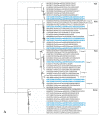Rotavirus A in Domestic Pigs and Wild Boars: High Genetic Diversity and Interspecies Transmission
- PMID: 36146832
- PMCID: PMC9503859
- DOI: 10.3390/v14092028
Rotavirus A in Domestic Pigs and Wild Boars: High Genetic Diversity and Interspecies Transmission
Abstract
Rotavirus A (RVA) is an important pathogen for porcine health. In comparison to humans, RVA in domestic animals and especially in wildlife is under researched. Therefore, the aim of the present study was to investigate the prevalence, genetic diversity, molecular epidemiology and interspecies transmission of RVA in domestic pigs and wild boars. During the three consecutive RVA seasons (2018-2021) we collected 445 and 441 samples from domestic pigs and wild boars, respectively. Samples were tested by real-time RT-PCR, and RVA-positive samples were genotyped in VP7 and VP4 segments. Our results report an RVA prevalence of 49.9% in domestic pigs and 9.3% in wild boars. Outstanding RVA genetic diversity was observed in VP7 and VP4 segments, especially in domestic pigs exhibiting a striking 23 different RVA combinations (G5P[13] and G9P[23] prevailed). Interspecies transmission events were numerous between domestic pigs and wild boars, sharing G3, G5, G6, G9, G11 and P[13] genotypes. Furthermore, our data indicate that such transmission events involved even bovines (G6, P[11]) and, intriguingly, humans (G1P[8]). This study contributes to the basic knowledge that may be considered important for vaccine development and introduction, as a valuable and currently missing tool for efficient pig health management in the EU.
Keywords: Croatia; domestic pig; genetic diversity; genotype; interspecies transmission; molecular epidemiology; phylogenetic analysis; rotavirus A; wild boar.
Conflict of interest statement
The authors declare no conflict of interest. The funding body had no role in the design of the study; in the collection, analyses or interpretation of data; in the writing of the manuscript, or in the decision to publish the results.
Figures






References
-
- Troeger C., Khalil I.A., Rao P.C., Cao S., Blacker B.F., Ahmed T., Armah G., Bines J.E., Brewer T.G., Colombara D.V., et al. Rotavirus Vaccination and the Global Burden of Rotavirus Diarrhea Among Children Younger Than 5 Years. JAMA Pediatr. 2018;172:958–965. doi: 10.1001/jamapediatrics.2018.1960. - DOI - PMC - PubMed
-
- Palmarini M. Reoviridae. In: MacLachlan N.J., Dubovi E.J., editors. Fenner’s Veterinary Virology. 5th ed. Academic Press; Boston, MA, USA: 2017. pp. 299–317.
-
- ICTV Rotavirus Taxonomy. 2021. [(accessed on 25 May 2022)]. Available online: https://talk.ictvonline.org/taxonomy/
Publication types
MeSH terms
LinkOut - more resources
Full Text Sources
Medical
Research Materials
Miscellaneous

